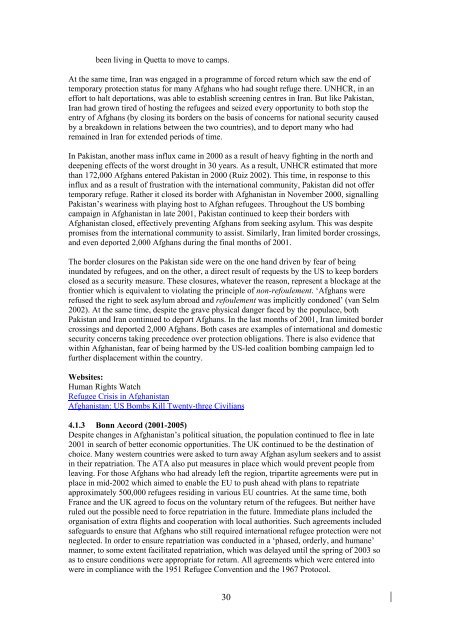Afghanistan. - Forced Migration Online
Afghanistan. - Forced Migration Online
Afghanistan. - Forced Migration Online
You also want an ePaper? Increase the reach of your titles
YUMPU automatically turns print PDFs into web optimized ePapers that Google loves.
een living in Quetta to move to camps.<br />
At the same time, Iran was engaged in a programme of forced return which saw the end of<br />
temporary protection status for many Afghans who had sought refuge there. UNHCR, in an<br />
effort to halt deportations, was able to establish screening centres in Iran. But like Pakistan,<br />
Iran had grown tired of hosting the refugees and seized every opportunity to both stop the<br />
entry of Afghans (by closing its borders on the basis of concerns for national security caused<br />
by a breakdown in relations between the two countries), and to deport many who had<br />
remained in Iran for extended periods of time.<br />
In Pakistan, another mass influx came in 2000 as a result of heavy fighting in the north and<br />
deepening effects of the worst drought in 30 years. As a result, UNHCR estimated that more<br />
than 172,000 Afghans entered Pakistan in 2000 (Ruiz 2002). This time, in response to this<br />
influx and as a result of frustration with the international community, Pakistan did not offer<br />
temporary refuge. Rather it closed its border with <strong>Afghanistan</strong> in November 2000, signalling<br />
Pakistan’s weariness with playing host to Afghan refugees. Throughout the US bombing<br />
campaign in <strong>Afghanistan</strong> in late 2001, Pakistan continued to keep their borders with<br />
<strong>Afghanistan</strong> closed, effectively preventing Afghans from seeking asylum. This was despite<br />
promises from the international community to assist. Similarly, Iran limited border crossings,<br />
and even deported 2,000 Afghans during the final months of 2001.<br />
The border closures on the Pakistan side were on the one hand driven by fear of being<br />
inundated by refugees, and on the other, a direct result of requests by the US to keep borders<br />
closed as a security measure. These closures, whatever the reason, represent a blockage at the<br />
frontier which is equivalent to violating the principle of non-refoulement. ‘Afghans were<br />
refused the right to seek asylum abroad and refoulement was implicitly condoned’ (van Selm<br />
2002). At the same time, despite the grave physical danger faced by the populace, both<br />
Pakistan and Iran continued to deport Afghans. In the last months of 2001, Iran limited border<br />
crossings and deported 2,000 Afghans. Both cases are examples of international and domestic<br />
security concerns taking precedence over protection obligations. There is also evidence that<br />
within <strong>Afghanistan</strong>, fear of being harmed by the US-led coalition bombing campaign led to<br />
further displacement within the country.<br />
Websites:<br />
Human Rights Watch<br />
Refugee Crisis in <strong>Afghanistan</strong><br />
<strong>Afghanistan</strong>: US Bombs Kill Twenty-three Civilians<br />
4.1.3 Bonn Accord (2001-2005)<br />
Despite changes in <strong>Afghanistan</strong>’s political situation, the population continued to flee in late<br />
2001 in search of better economic opportunities. The UK continued to be the destination of<br />
choice. Many western countries were asked to turn away Afghan asylum seekers and to assist<br />
in their repatriation. The ATA also put measures in place which would prevent people from<br />
leaving. For those Afghans who had already left the region, tripartite agreements were put in<br />
place in mid-2002 which aimed to enable the EU to push ahead with plans to repatriate<br />
approximately 500,000 refugees residing in various EU countries. At the same time, both<br />
France and the UK agreed to focus on the voluntary return of the refugees. But neither have<br />
ruled out the possible need to force repatriation in the future. Immediate plans included the<br />
organisation of extra flights and cooperation with local authorities. Such agreements included<br />
safeguards to ensure that Afghans who still required international refugee protection were not<br />
neglected. In order to ensure repatriation was conducted in a ‘phased, orderly, and humane’<br />
manner, to some extent facilitated repatriation, which was delayed until the spring of 2003 so<br />
as to ensure conditions were appropriate for return. All agreements which were entered into<br />
were in compliance with the 1951 Refugee Convention and the 1967 Protocol.<br />
30
















